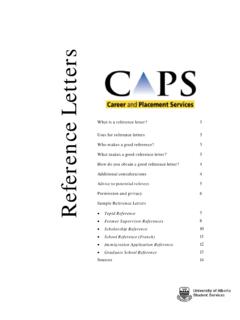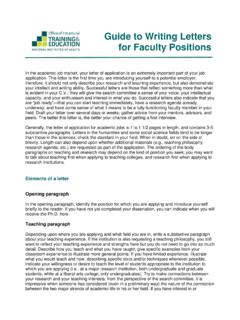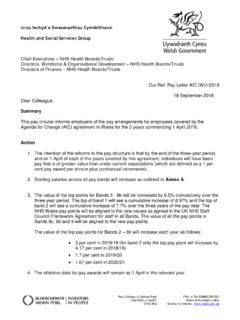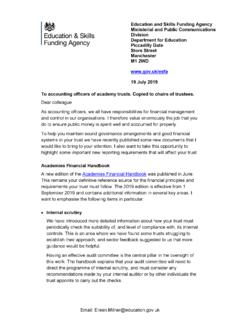Transcription of Annual National Flu programme 2018
1 26 March 2018. Dear colleague, The National flu immunisation programme 2018/19. This letter (flu letter : no. 1) provides information about which patients and children are eligible for vaccination in the flu immunisation programme for 2018/19. A. second letter will follow in late spring with information about frontline healthcare workers and social care workers. Eligibility 1. In 2018/19 the one change in eligibility is the extension to an additional cohort of children, those in school year 5. Therefore, in 2018/19 the following are eligible for flu vaccination: all children aged two to nine (but not ten years or older) on 31 August 2018.
2 All primary school-aged children in former primary school pilot areas those aged six months to under 65 years in clinical risk groups pregnant women those aged 65 years and over those in long-stay residential care homes carers 2. In addition, vaccination is recommended for frontline health and social care workers (see letter to follow). National flu immunisation priorities 3. The last season's higher level of flu activity is an important reminder that flu can have a significant impact and is highly unpredictable. This year saw record flu vaccination levels, with nearly one and a half million more people getting the vaccination than last year.
3 We should strive to further improve vaccine uptake rates in all eligible cohorts next year. 1. PHE Gateway Ref: 2017863. NHS England Gateway Ref: 07808. The National flu immunisation programme 2018/19. 4. NHS England has already written to GPs, community pharmacies and Clinical Commissioning Groups to confirm that the most effective flu vaccines for the population should be ordered, for the 2018/19 flu season. Based on the advice of the Joint Committee on Vaccination and Immunisation (JCVI), providers should offer: the adjuvanted trivalent vaccine (aTIV) for all 65s and over. NHS England has recommended that the adjuvanted trivalent influenza vaccine (aTIV) be made available to all those aged 65 and over in 2018/19.
4 This is the most effective vaccine currently available for this group. This reflects current JCVI. advice and Green Book guidance published in December 2017 by Public Health England (PHE). Note: JCVI considers aTIV to be more effective and cost- effective than the non adjuvanted vaccines currently in use in the elderly (including quadrivalent vaccine (QIV)). the quadrivalent vaccine (QIV) for 18 under 65s at risk. NHS England has recommended that adults aged 18 to under 65 in clinical at-risk groups are offered the quadrivalent influenza vaccine (QIV) which protects against four strains of flu.
5 This reflects current JCVI advice and Green Book guidance that was updated in October 2017 on the basis of cost-effectiveness data produced by PHE. 5. The live attenuated influenza vaccine (LAIV) used for the children's programme is also quadrivalent. We ask that increased effort is given to the vaccination of preschool children as uptake is not as high as in schools. The effectiveness of LAIV offered to children is good; furthermore children under the age of five years old have the highest rate of hospital admissions for flu of all age groups. Improving uptake in these children and children with an underlying clinical risk factor will provide individual protection as well as helping to protect the wider community.
6 Vaccine uptake ambitions 6. Vaccine uptake ambitions for 2018/19 are similar to previous years. The long- term ambition for eligible adults is a minimum 75% uptake rate is achieved, as recommended by the World Health Organization. In the case of at risk groups the ambition is an interim one because current uptake is some way from 75%. 7. As a key objective in the children's programme is to maximise reduction of flu transmission, in addition to individual protection, the ambition beyond 2018/19. will be based on levels of vaccine uptake needed to achieve this impact. The proposed ambitions are different for the preschool and school-aged children as achieving higher uptake in general practice is more challenging than in schools.
7 2. The National flu immunisation programme 2018/19. Table 1: Vaccine uptake ambitions in 2018/19. Eligible groups Uptake ambition Routine programme Aged 65 years and 75%, reflecting the World Health Organization (WHO). over target for this group. Aged under 65 at At least 55% in all clinical risk groups*, and risk', including maintaining higher rates where those have already pregnant women been achieved. Ultimately the aim is to achieve at least a 75% uptake in these groups given their increased risk of morbidity and mortality from flu. Children's programme Preschool children At least 48% with most practices aiming to achieve higher.
8 Aged 2 and 3. years old School aged An average of at least 65% to be attained by every children (in provider across all years. reception class &. years 1 to 5). * interim ambition 8. Providers should actively invite 100% of eligible individuals ( by letter , email, phone call, text) and ensure uptake is as high as possible. Providers and commissioners will be required, if asked, to demonstrate that such an offer has been made. The benefits of the vaccine among all recommended groups should be communicated and vaccination made as easily accessible as possible. Timing 9. Although the enhanced service specification for flu includes payment for vaccines given up until 31 March 2019, vaccination, using the most effective vaccine, should be given as soon as possible to provide protection before flu starts to circulate.
9 Ideally vaccination should be completed by the end of November. 10. In general it is appropriate to still offer vaccination to eligible patients at any subsequent point in the flu season, even if they present late for vaccination. This can be particularly important if it is a late flu season or when newly at risk 3. The National flu immunisation programme 2018/19. patients present, such as pregnant women who may have not been pregnant at the beginning of the vaccination period. The decision to vaccinate should take into account the level of flu-like illness in the community, bearing in mind that the immune response to vaccination takes about two weeks to develop fully.
10 11. It should be noted that for the children's programme , LAIV has a short shelf life and there will only be limited availability of vaccine late in the season. Conclusion 12. We thank everyone for their hard work in supporting the programme and the significant contribution this makes to reducing illness and death from flu. Flu is a major cause of harm to individuals and a key factor in NHS winter pressures. Preventing flu infection through vaccination also contributes to preventing secondary bacterial infections such as pneumonia. This can help reduce the need for antibiotics and contribute towards preventing antibiotic resistance.













